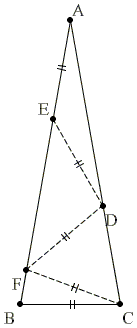Consecutive Isosceles Decomposition
From one of the solutions to a problem related to the 80-80-20 isosceles triangle, we know that the latter can be decomposed into four isosceles triangles with the bases on the legs of the given triangle.

Below, we follow an article by Roza Leikin who considered a generalized problem: which isosceles triangles (defined by, say, their apex angle) possess what she called "Consecutive Isosceles Division"? I'll use the term "Consecutive Isosceles Decomposition", instead, and the same abbreviation, CID.
Reference
|Contact| |Front page| |Contents| |Geometry| |Up|
Copyright © 1996-2018 Alexander Bogomolny
For the original 80-80-20 triangle, we found a 4-triangle decomposition into 20-20-140, 40-40-100, 60-60-60, and 80-80-20 triangles. Note that the base angles form an arithmetic sequence 20, 40, 60, 80 (as are the apex angles.)
We shall prove that the same pattern holds for every CID decomposition. Indeed, let Pk-1PkPk+1 and PkPk+1Pk+1 be two adjacent triangles of such a decomposition, one with base ![]() Pk+1PkPk+2 = β,
Pk+1PkPk+2 = β,

In the next triangle down the diagram, i.e. ΔPk-2Pk-1Pk, the base ∠Pk-1PkPk-2 is found to be
∠Pk-1PkPk-2 = 180° - (180° - 2α - β) = 2α - β,
with the same difference α - β from the previous base angle α.
Assume that an isosceles triangle ABC (AB = AC) with the apex angle of γ admits an n-term CID. The top triangle has an apex angle of (180° - 2γ) so that the next triangle's base angle is
180° - (180° - 2γ) = 2γ
implying that the difference of the arithmetic sequence of the base angles in the CID is equal γ, the apex angle of ΔABC. The base angle of ΔABC is clearly
γ + (n - 1)·γ = (180° - γ)/2,
from which
γ = 180° / (2n + 1).
Note that such an angle is half the central angle between two consecutive vertices of a regular (2n+1)-gon.
As we've seen, for γ = 20°, i.e. for the 80-80-20 triangle,
|Contact| |Front page| |Contents| |Geometry| |Up|
Copyright © 1996-2018 Alexander Bogomolny
71752640
